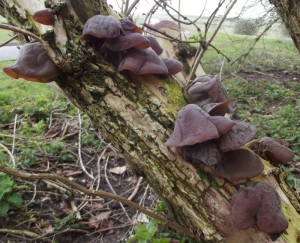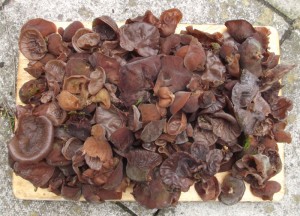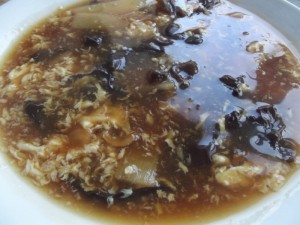13/04/2013
At least nobody is going to argue about its latin name! In this case, the latin name was derived from an English common name that predates it (Judas’ ear) and which is still in common usage in the slightly altered form of “Jew’s ear.”
There has recently been an attempt to change this common name. In 2003 the British Mycological Society published a new list of common names for fungi, and in most cases the motivation where there was a new (or newly “official”) name was either to provide a common name for species that had none or to select one common name for species that had several. Where possible there was also an attempt to make them more taxonomically consistent, although this has only been partially successful due to many changes in latin names due to advances in our understanding of fungal taxonomy as a result of widespread genetic testing. This species was a special case, because it was the only one where the motivation was that of political correctness, the claim being that “Jew’s ear” is anti-Semitic. My own view concurs with that of mycologist Patrick Harding – that this an abuse of the English language and that the BMS should be concerned with fungi, not politics, religion or the evolution of the English language. I see no reason to believe this has anything to do with anti-Semitism. Judas Iscariot was a Jew, and the mythology in question is an integral part of the Christian religion – this species is found most frequently on elder trees, either dead or alive, and it was an elder tree from which Judas supposedly hung himself. If this is going to be considered anti-Semitic then the whole Christian religion must be considered anti-Semitic. This it may be, but it is not the place of the BMS to get involved in such issues. If people have a problem with the anti-Semitic nature and history of Christianity, then I suggest they take it up with their local church, or maybe the Archbishop of Canterbury. I shall continue to call this fungus “Jew’s ear.” If other people want to call it “jelly ear” then that’s up to them.
The naming situation is further complicated by the fact that although this particular species has never been widely consumed in its home territory of northern Europe, it has a close relative which is an important culinary and medicinal species in several south-east Asian countries, especially China. Auricularia polytricha, known in China as “wood ear” or “cloud ear”, and in Japan as kikurage or “tree jellyfish”, is taxonomically distinct, but there is no important difference from a culinary or medicinal point of view.
Jew’s ear is very common and can sometimes be found in vast quantities. One of those times is right now, at least in my home territory of Sussex. This is the second fruiting of this year. I found quite a bit of it around Christmas and New Year, but haven’t seen much of it since then, until two days ago, when I found this lot. Plenty more were coming through, so I decided to pick a large bagful and experiment with it, there being very little else in the way of edible fungi available right now (though this is going to change in the very near future when the warmer weather finally arrives from tomorrow onwards.) There are no similar poisonous species, so this one is reasonably safe for beginners to collect (although not entirely foolproof – I saw somebody get it wrong on the internet last year.)
And experimentation may well be required if you’re going to do anything culinary with it. I’m not going to provide any recipes here, but I can point readers in the general direction of two culinary uses.
The first comes from Roger Phillips’ seminal book “Wild Food.” That book contains a recipe for Jew’s ear rolls, which are basically “swiss rolls” made from soft, sliced white bread with a jew’s ear, garlic and herb filling. It took me several attempts to get this recipe right. The fungus has to be cooked on a very low heat for at least twenty minutes. If the heat is too high then the garlic will burn and the fungus is likely to explode and end up all over your kitchen walls – or in your eyes, so watch out. If it is not cooked for long enough then it will be too rubbery. And you have to use the right sort of bread or the rolls won’t roll properly. Once you have got to the stage of getting the rolls rolled, and staked with a cocktail stick, then they can be coated with butter and placed in an oven to brown. I finally got the recipe to work at the third attempt, and was very pleased with the result.
The second is the most common traditional usage from Asian cooking, and that is hot and sour soup. I’m not going to recommend any particular recipe because I’m no expert on Chinese food and there are literally hundreds of versions of hot and sour soup. It is an entire genre rather than a specific dish. I was pleasantly surprised by the version I cobbled together yesterday, which involved bamboo shoots, chicken stock, fresh ginger, red wine vinegar, dark soy sauce and a beaten egg.
Anyway, if you want to try foraging for this species, now is a good time to go looking.




Why not call it “Judas’ ear” then?
Hi The Lynezian,
Simply because that’s not the common name in frequent current usage. “Judas’ Ear” became “Jew’s Ear” because the latter is easier/quicker to say. A lot of English terms evolve in this way.
Geoff
I refuse to promote medieval religious bigotry.
The name Jews or Judas’ ear was given to it to make the tree that it grew on, and the hag that people believed lived in the tree, into something scurilous.
The Elder tree that the fungi grows upon is incredibly useful; it is everything from food to medicine to dyestuff and tinder, but it has a quirk. It is untrustworthy to climb. So superstition came to play and folks ‘asked’ the tree for a branch, for flower, leaf or fruit.
The Elder is known as the Boor tree. The rhyme goes,
“Boor tree, boor tree, crookit rung,
Ever weak and never strong,
Flower and fruit, baith sae sweet,
Ne’er trust a stick beneath your feet”
But even that was changed by the christians to suit their own propaganda.
The early christian church had a bad habit of decrying anything that was given any regard that was not in praise of their god. Judas sold out Christ to the Romans, and in Medieval Europe there were occasions when Jews were mutilated and their ears cut off, so the ear must be his….except the Elder never grew in Israel, and there was no way that it was ever used as the wood for the cross.
I work with the public, and I teach children too; they have no concept of Jewish ears as belonging on any tree. They are as sickened by the thought of such religious and political mutilation in the past as they would be if it were to happen now.
The world moves along, and if fungi are to have a relevance and to be considered worth promoting and protecting, then common names need to be descriptive and relevant. Jelly ear or tree ear are both.
MC
Hi Mary,
Thankyou for your contribution to this discussion.
RE: “I work with the public, and I teach children too; they have no concept of Jewish ears as belonging on any tree.”
One of the common names of Coprinus comatus is “Lawyer’s Wig”. Do you think children/”the public” think that this name indicates that this mushroom has something to do with real lawyers or real wigs? Does Agaricus augustus – “The Prince” – have something to do with a real prince? Does a “fairy inkcap” have something to do with supposedly-real fairies? Does Clathrus archerii – “Devils’ Fingers” – have something to do with a supposedly-real devil?
I understand your concerns (at least I think I do), but I’m also exasperated at the fact that in addition to a large proportion of the latin names of fungi being changed due to improved knowledge of fungal taxonomy, changes to common names are also being imposed on the users of the English language. Perhaps I’m just being a bit too conservative.
However, you have also touched on the more-serious side of this discussion, and that is the bigotry and otherwise-unhelpful behaviour of “the early Christian Church.” And, sadly, I’m not sure whether it was really just the “early” church that is associated with these problems. The modern-day Christian church, especially the Roman Catholic variety, is not exactly noted for its lack of bigotry, or for its tolerance of non-Christian systems of belief or ethics. There is a very real and serious debate to be had about those things – I’m just not sure it has much to do with fungi, and not at all sure that changing the name of this fungus, at this point, is going to make the slightest bit of difference. In fact, you could even look at it completely the other way around. If you are going to teach children about this fungus, then instead of insisting on a change to a long-standing common name which is a direct translation of its long-standing latin name, you could use it as an opportunity to point out some of these problem concerning religious bigotry. You could use it as a way of making those children (and, for that matter, adults, since the majority know very little about this either) more aware of the true history of the abrahamic religions. There is a great deal that the early Christian Church (and the mediaevil Christian Church, and the modern Christian Church) has suppressed about its own history and its place in the history of the western world. The fact of the matter is this: Christianity *is* anti-Jewish, and always was. Why, one might ask oneself, did a pro-Roman, pacificist religion arise in a first-century state which was occupied by the Romans? Wouldn’t it make more sense that an anti-Roman, rebellious religion would arise from the messianic Judaism which was a real political and religious force in first-century Judea? I personally believe that one might end up tending towards the answer that the Christianity which emerged in the late 1st century and started growing rapidly in the 2nd was actually an invention of the Romans themselves, specifically the Flavians. And if this is indeed the case, then it is not particularly surprising that this religion is anti-Jewish and pro-Roman!
There is much that can be said about this, I think. But it has very little to do with a small, brown, edible fungus that grows on elder trees, and I don’t think changing the name of this fungus is going to help in any way to reduce the problems caused to our society by religious bigotry, nor will it raise awareness of the distortions and propaganda associated with Christianity and the other Abrahamic religions, both now and historically.
Geoff
Every time you say or write Jew’s ear in reference to the fungi the image is of mutilated people with their ears nailed onto a tree because of religious and racist intolerance and bigotry.
If you wish to make fungi of interest, of importance re conservation, of relevance, then their immediate description matters.
Most people will never learn the latin roots and while I do use them in discussion with both the public and children, it’s the common name that sticks. Lawyers still wear wigs, so the name is relevant. Penny bun looks like it belongs in a bakery, destroying angel, puffball, earthstar, devil’s hoofnail, elfcup……all relevant, all descriptive, all memorable. So is jelly ear, or tree ear.
Will I spend quarter of an hour explaining an offensive name every time I mention the fungus ? No, and I know from experience that very few people working with the public will either. Suggesting that we use it to confront bigotry simply gives it airtime. It’s a can of worms this one. Time to move on and consign the name to outdated history books.
Kind regards,
Mary
Hi Mary,
OK…I think it would be best for us to agree to disagree on this one! Thanks again for your input and I hope people will read these replies and make up their own minds.
Geoff
> In this case, the latin name was derived from an English common name that predates it (Judas’ ear)
What evidence do you have that this English common name predates the latin name? That seems tremendously unlikely.
Hi Colin
This does need some clarification. This species was already called “Judas’ Ear” or “Jew’s Ear” in English by the 16th century (the source for this is wikipedia). It is the oldest English common name of a fungus that is still in use, and predates the invention of Latin binomial nomenclature by at least 150 years. However, in this case the binomial Latin name was derived from the archaic Latin common name – it was already called “auricula Judae” (literally “The ear of Judas”) in prescientific Latin. It was referred to as such in John Gerard’s Herbal, published in 1597, and Gerard plagiarised this from the work of Flemish botanist/herbalist Rembert Dodoens, earlier in the 16th century.
Geoff
Reply to Mary Craig.
“Every time you say or write Jew’s ear in reference to the fungi the image is of mutilated people with their ears nailed onto a tree ”
Do you have a source for this information? I’ve never heard of such a practice myself.
Referring specifically to the practice of having one’s ear nailed to a pillory…
https://en.wikipedia.org/wiki/Cropping_(punishment)